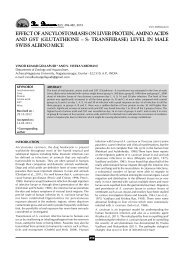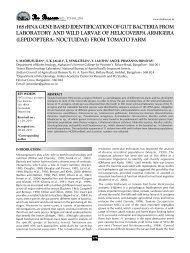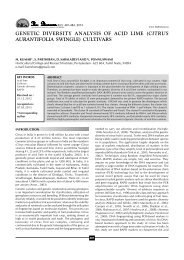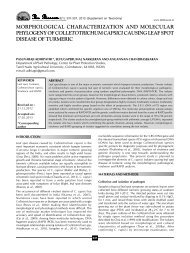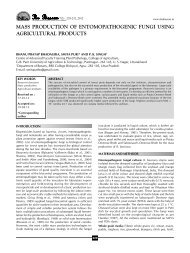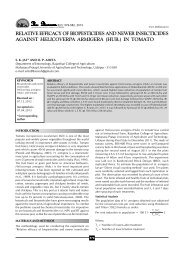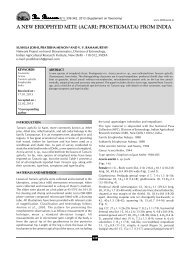NSave Nature to Survive - THE BIOSCAN
NSave Nature to Survive - THE BIOSCAN
NSave Nature to Survive - THE BIOSCAN
Create successful ePaper yourself
Turn your PDF publications into a flip-book with our unique Google optimized e-Paper software.
JOGEN CH. KALITA et al.,<br />
gelius, Mystus cavasius, Mystus bleekeri, Tetradon cutcutea<br />
and Chacca chacca were occurred in very low quantities and<br />
their population status was also found <strong>to</strong> be in decreasing<br />
order (Table 4). Among the fishes of minor group about 19<br />
species were of ornamental value. Unfortunately, these fishes<br />
having high ornamental value were found <strong>to</strong> be brought <strong>to</strong><br />
the market as ordinary food fish with a minimum market price.<br />
Fish catch statistics<br />
The fish catch statistics during the study period clearly<br />
indicated that the fishes belonging <strong>to</strong> the major group were<br />
gradually decreasing from 54% in the year 2000 <strong>to</strong> 26%<br />
recorded in the year 2006 (Table 5). Similarly the fishes<br />
belonging <strong>to</strong> intermediate group decreased from 21% in 2000<br />
<strong>to</strong> 18% in 2006. However, the fishes of minor group comprised<br />
of 25% of the <strong>to</strong>tal catch during the year 2000 while during<br />
the year 2006 it was recorded as 66% of the <strong>to</strong>tal catch. The<br />
statistical analysis clearly indicated that the fishes belonging<br />
<strong>to</strong> the major and intermediate groups were in decreasing order.<br />
On the other hand, the <strong>to</strong>tal catch of fish during the year 2000<br />
was recorded as 55 metric <strong>to</strong>n (MT) and this value decreased<br />
<strong>to</strong> 38 MT during the year 2006 (Table 5).<br />
The Natural wetlands provide the habitat for diversified air<br />
breathing as well as other indigenous ichthyo-species. Several<br />
workers notably Welch (1952), Hora and Pillay (1962),<br />
Dehadrai and Tripathi (1976) have studied the characteristics<br />
of swamps, marshes and wetlands from different environment,<br />
which were identified as the natural habitat of different fish<br />
species. Similarly, the present investigation was conducted in<br />
Koya Kujia Beel of Bongaigaon district of Assam and the<br />
physico-chemical conditions of water along with the plank<strong>to</strong>n<br />
composition and the ichthyo-faunal diversity in the beel was<br />
been critically analyzed. Temperature is one of the most<br />
significant parameter among the physical and chemical<br />
attributes of the water environment, which directly and<br />
indirectly influence on almost all the living processes of the<br />
aquatic organisms. Being the poikilothermic animal, fish has<br />
the ability <strong>to</strong> adapt and live at very different temperature<br />
gradients but it affects on the general metabolism of fishes.<br />
The present finding reveals that the water temperature of Koya<br />
Kujia Beel is in the suitable range for growth and development<br />
of fish.<br />
The water transparency is another important physical attribute,<br />
which acts as a productivity indica<strong>to</strong>r of the water body. It is<br />
directly related with the quantity of suspended particles and<br />
biotic community present in water (Jhingran, 1985). Banerjee<br />
(1967) has reported that the water transparency less than 30<br />
cm and more than 70 cm is generally less productive and<br />
affect the growth and productivity of fish. In the present findings<br />
the water transparency of the beel is found within highly<br />
productive range (42.0-95.0 cm). Similarly all the chemical<br />
parameters like dissolved oxygen, free carbon dioxide, <strong>to</strong>tal<br />
alkalinity, <strong>to</strong>tal hardness, calcium and magnesium<br />
concentration of the studied water body have been recorded<br />
within the suitable range for growth and development of fish<br />
and other aquatic organisms (Table 1). Hydrogen ion<br />
concentration (pH) is an indica<strong>to</strong>r of various attributes of water<br />
body. It has direct and indirect effects on the growth and<br />
development of aquatic organisms including fishes. The pH<br />
of any water body generally undergoes diurnal as well as<br />
430<br />
seasonal variation. However, the optimum pH level of water<br />
for fish culture ranges from 6.5 <strong>to</strong> 8.5 (Banerjee, 1967;<br />
Jhingran, 1985). In the present investigation the pH range of<br />
the beel water has been recorded from 6.0 <strong>to</strong> 8.9 (Table 1).<br />
This corroborates the findings of several workers in different<br />
wetlands of Assam (Dey, 1981; Lahon, 1983; Goswami, 1985;<br />
Agarwal, 1996).<br />
Dissolved organic matter concentration depends on the rate<br />
of decomposition of organic matters and the nature of soil.<br />
Higher value of DOM is the characteristic of swamp, which is<br />
due <strong>to</strong> decomposition of organic matters (Munshi and Hughes,<br />
1991). In the present investigation higher value of DOM<br />
concentration was found in the beel water (3.45 mg L-1 ) (Table<br />
1). This higher DOM was resulted due <strong>to</strong> prolonged stagnation<br />
of water and decomposition of detritus in the burrows. Higher<br />
DOM is an indica<strong>to</strong>r of nutrient rich water (Munshi and<br />
Hughes, 1991), which also gives support <strong>to</strong> nutrient flow in<strong>to</strong><br />
the burrows from the overlying swamps. This result of the<br />
present study coincides with the findings in different wetlands<br />
of Assam (Dey, 1981; Lahon, 1983; Goswami, 1985; Dey and<br />
Kar, 1987; Yadav, 1987; Agarwal, 1996; Thakuria and Sarma,<br />
2005; Kalita and Goswami, 2006). Plank<strong>to</strong>n is of immense<br />
value as food, indica<strong>to</strong>r of various physico-chemical and<br />
biological properties of natural water body. Several authors<br />
contributed their works on the importance of plank<strong>to</strong>n on the<br />
productivity of water body and role in aquaculture in different<br />
aspects (Pennak, 1953; Edmondson, 1959; Goswami, 1985).<br />
Present study reveals that the studied beel was rich with 31<br />
different species of zooplank<strong>to</strong>n (Table 2) and 12 species of<br />
phy<strong>to</strong>plank<strong>to</strong>n (Table 3), which exhibits a congenial<br />
environment for fish growth in the beel.<br />
In the present investigation it has been observed that most of<br />
the physico-chemical and biological attributes provide<br />
congenial environment of the beel for fish growth. However,<br />
the study of fish catch statistics reveals that the population<br />
status of different fish species was gradually declining (Table<br />
5). The local fishermen and the lessee of the beel also<br />
confirmed the same phenomena. Majorty of the Indian major<br />
carps and some commercially important fishes like Channa<br />
striatus, C. marulius, Aorichthys seenghala, Aorichthys aor,<br />
Wallago attu had been recorded as critically declining species<br />
in the beel. Moreover, a variety of ornamental fish species<br />
were recorded and found declining drastically (Table 4). The<br />
fish catch statistics of the beel also supported that the population<br />
status of most of the fishes are in declining trend. Moreover,<br />
the water area of the Koya Kujiya Beel expanded from 0.36<br />
km2 in January, 1997 <strong>to</strong> 0.42 km2 in February, 2006. This is<br />
because of the clearance of the unusual growth of vegetation<br />
of the beel under the National Rural Employment Guarantee<br />
Programme (NREGP) from August, 2006. On the other hand,<br />
the other waterbodies, which had occupied 0.40 km2 in 1997,<br />
has shrunk <strong>to</strong> 0.34 km2 in the year 2006. The shrinking of the<br />
beel caused by the deposits carried down from the adjoining<br />
areas, which indicates over exploitation and encroachment<br />
around the beel. It was found that the villagers were using<br />
chemical fertilizers in their agricultural field. During rainy<br />
season the run off water along with eroded materials carry<br />
some amount of dissolved chemical substances from its<br />
surrounding agricultural fields <strong>to</strong> its low lying areas. As such



